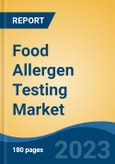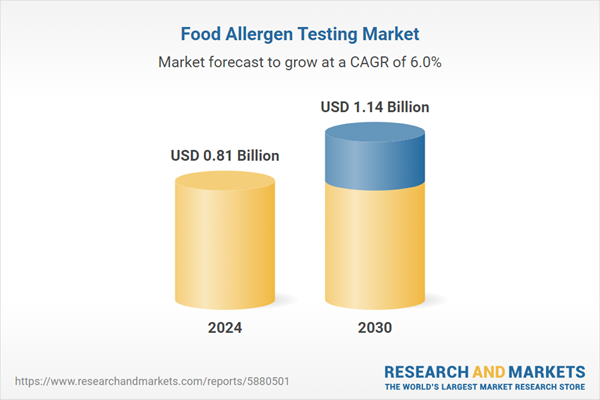Speak directly to the analyst to clarify any post sales queries you may have.
10% Free customizationThis report comes with 10% free customization, enabling you to add data that meets your specific business needs.
The rising incidence of food allergies, particularly among children, has prompted stricter regulatory frameworks and heightened consumer awareness globally. Regulatory bodies such as the U.S. FDA, European Food Safety Authority (EFSA), and FSSAI in India have implemented stringent guidelines mandating the identification, testing, and labeling of key allergens in food products. These regulations require manufacturers to adopt advanced allergen testing methods like ELISA (Enzyme-Linked Immunosorbent Assay), PCR (Polymerase Chain Reaction), and lateral flow assays to ensure accurate and timely detection. As food supply chains become more complex and globalized, the risk of cross-contamination has also increased, emphasizing the need for comprehensive allergen management systems.
Key Market Drivers
Rising Cases of Food Allergies
Food allergies have become a pressing public health issue, especially among children, who are disproportionately affected. Children with food allergies are two to four times more likely to suffer from asthma or other allergic conditions, intensifying the need for proactive management. According to a 2023 report, nearly 6 million children in the U.S. live with at least one food allergy. The heightened risk of severe allergic reactions, including anaphylaxis, has underscored the importance of routine testing and early diagnosis, driving demand for reliable allergen detection tools across healthcare and food sectors.The nature and persistence of food allergies vary by the allergen. While some allergies like milk and egg tend to diminish with age, others such as peanut and shellfish often last a lifetime. In 2022, a study showed that over 80% of children with peanut allergies do not outgrow them. The rise of related conditions such as lactose intolerance, gluten sensitivity, and soy allergies has further expanded the range of allergens food manufacturers and testing labs must screen for. This growing complexity reinforces the need for comprehensive allergen panels and sophisticated testing methodologies to ensure consumer safety.
In response to rising allergy cases and regulatory demands, food testing labs are increasingly investing in strategic partnerships and technology upgrades. A notable example is Eurofins Scientific's 2022 acquisition of a majority stake in Ajal Laboratories to enhance its food and pharmaceutical testing footprint in the Middle East. Such collaborations allow labs to broaden their allergen testing capabilities and comply with region-specific standards. In parallel, advancements in rapid testing technologies are enabling faster and more accurate allergen identification, helping producers prevent contamination incidents before products reach the market.
Governments and health organizations worldwide are actively engaging in education and prevention efforts. Campaigns focused on label transparency, early detection, and emergency preparedness are gaining momentum. A 2023 European study found that more than 40% of parents with allergic children reported receiving improved allergy education through school and healthcare channels. These collaborative efforts between public health authorities, private testing labs, and advocacy groups are instrumental in raising awareness, reducing mislabeling incidents, and promoting allergen-free product innovation in the global food supply chain.
Key Market Challenges
Stringent Food Safety Regulations
Numerous obstacles impede the accurate diagnosis of food allergies (FA) in developing regions. Evidence suggests that parents and healthcare workers in these areas lack sufficient knowledge about food allergies, and in vitro diagnostic tests are not easily accessible. Early diagnosis of FA is crucial for prognosis and proper nutritional management. However, even in developed countries, there is a reported diagnostic lag of four months, particularly in infants with less severe manifestations of non-IgE mediated milk allergy. This situation is likely worse in developing countries, as Aguilar-Jasso et al. discovered a 38-month delay in the diagnosis of FA in North-Western Mexico.The lack of food control infrastructure and resources in developing countries, as well as technical difficulties in sampling, testing, and protein identification, are expected to hinder market growth. Currently, Middle Eastern and African countries, along with other low-income nations, face limitations due to low awareness about food allergens and intolerance testing.
Key Market Trends
Rapid Testing Methods
There was a growing demand for rapid allergen testing methods that provide quick and accurate results. These methods allowed for faster decision-making in food production and distribution, enabling timely recalls or corrective actions if allergens were detected.Advancements in testing technologies were leading to improved sensitivity and specificity in allergen detection. High sensitivity allowed for the detection of allergens at lower concentrations, while high specificity reduced the risk of false positives. Point-of-care allergen testing devices and kits were emerging, allowing for on-site testing at food processing facilities and restaurants. Point-of-care testing offered real-time results, facilitating rapid decision-making and allergen management.
Key Market Players
- 3M
- Als Limited
- Asurequality Limited
- Auriga Research
- Bureau Veritas
- Eurofins Scientific Se
- Intertek Group Plc
- Merieux Nutrisciences
- Microbac Laboratories Inc
- Neogen Corporation
Report Scope:
In this report, the Global Food Allergen Testing Market has been segmented into the following categories, in addition to the industry trends which have also been detailed below:Food Allergen Testing Market, By Test Type:
- Allergen Testing
- Intolerance Testing
Food Allergen Testing Market, By Source:
- Peanut and Soy
- Wheat
- Milk
- Egg
- Tree Nuts
- Seafood
- Others
Food Allergen Testing Market, By Technology:
- PCR (Polymerase Chain Reaction)-Based
- Immunoassay Based/ELISA
- Other Tests/Techniques
Food Allergen Testing Market, By Food Type:
- Bakery and Confectionery
- Infant Food
- Processed Food
- Dairy Products and Alternatives
- Seafood and Meat Products
- Other Foods
Food Allergen Testing Market, By Region:
- North America
- United States
- Canada
- Mexico
- Europe
- France
- United Kingdom
- Italy
- Germany
- Spain
- Asia-Pacific
- China
- India
- Japan
- Australia
- South Korea
- South America
- Brazil
- Argentina
- Colombia
- Middle East & Africa
- South Africa
- Saudi Arabia
- UAE
Competitive Landscape
Company Profiles: Detailed analysis of the major companies present in the Global Food Allergen Testing Market.Available Customizations:
With the given market data, the publisher offers customizations according to a company's specific needs. The following customization options are available for the report.Company Information
- Detailed analysis and profiling of additional market players (up to five).
Table of Contents
Companies Mentioned
- 3M
- Als Limited
- Asurequality Limited
- Auriga Research
- Bureau Veritas
- Eurofins Scientific Se
- Intertek Group Plc
- Merieux Nutrisciences
- Microbac Laboratories Inc
- Neogen Corporation
Table Information
| Report Attribute | Details |
|---|---|
| No. of Pages | 189 |
| Published | August 2025 |
| Forecast Period | 2024 - 2030 |
| Estimated Market Value ( USD | $ 0.81 Billion |
| Forecasted Market Value ( USD | $ 1.14 Billion |
| Compound Annual Growth Rate | 6.0% |
| Regions Covered | Global |
| No. of Companies Mentioned | 10 |









